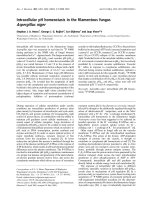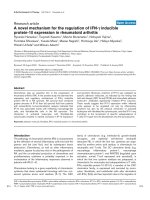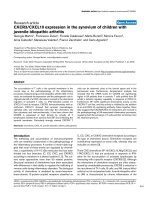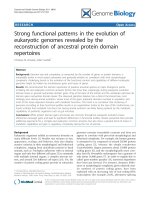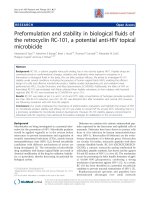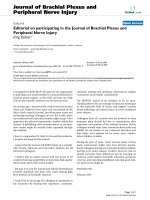Báo cáo y học: "Providing HIV care in the aftermath of Kenya''''s post-election violence Medecins Sans Frontieres'''' lessons learned January – March 2008" docx
Bạn đang xem bản rút gọn của tài liệu. Xem và tải ngay bản đầy đủ của tài liệu tại đây (194.53 KB, 5 trang )
BioMed Central
Page 1 of 5
(page number not for citation purposes)
Conflict and Health
Open Access
Short report
Providing HIV care in the aftermath of Kenya's post-election
violence Medecins Sans Frontieres' lessons learned January – March
2008
Tony Reid*
1
, Ian van Engelgem
2
, Barbara Telfer
3
and Marcel Manzi
4
Address:
1
MSF Brussels, rue Dupre 94, Brussels 1090, Belgium,
2
Former medical coordinator, MSF Kenya, Belgian Technical Cooperation, 41 rue
Depute Kayuku – Kiyovu, BP 6089, Kigali, Rwanda,
3
Former epidemiologist, MSF Kenya, Medicos Sem Fronteiras, Belgica-Maputo, Avenida
Agostinho Neto N1024, Maputo, Moçambique and
4
FUCHIA Data Manager, MSF Luxembourg, rue de Gasperich 68, L-1617, Luxembourg
Email: Tony Reid* - ; Ian van Engelgem - ; Barbara Telfer - ;
Marcel Manzi -
* Corresponding author
Abstract
Kenya's post-election violence in early 2008 created considerable problems for health services, and
in particular, those providing HIV care. It was feared that the disruptions in services would lead to
widespread treatment interruption. MSF had been working in the Kibera slum for 10 years and was
providing antiretroviral therapy to 1800 patients when the violence broke out. MSF responded to
the crisis in a number of ways and managed to keep HIV services going. Treatment interruption
was less than expected, and MSF profited from a number of "lessons learned" that could be applied
to similar contexts where a stable situation suddenly deteriorates.
Background
Following the disputed presidential election in Kenya in
December 2007, widespread violence broke out resulting
in an estimated 1500 people killed and 600,000 displaced
from their homes.[1] Although problems had occurred
during previous elections, this level of violence was
unprecedented in Kenya, a country regarded as a model of
democracy and stability. The rapid escalation of events
caught many services off guard, and health care was signif-
icantly disrupted.
The violence was particularly severe in Kibera, a large slum
near Nairobi where Medecins Sans Frontieres (MSF) has
been operating three primary health care centers. Medical
services in these areas were rapidly affected and there was
concern that patients with HIV, in particular, would be
unable to obtain their medications, resulting in treatment
interruption. The problem was compounded since many
patients and health care staff had returned to their home
villages to vote, and were prevented from returning to
Nairobi due to the violence.
MSF's three clinics in Kibera had been providing compre-
hensive primary care in addition to full HIV services,
including Highly Active AntiRetroviral Therapy (HAART)
for several years. By the end of 2007, 5200 patients were
enrolled in the HIV program and 1800 were on HAART.
[2]
This report describes MSF's response to the challenges of
providing HIV services in Kibera slum during the post-
election violence. The experience produced some lessons
Published: 4 December 2008
Conflict and Health 2008, 2:15 doi:10.1186/1752-1505-2-15
Received: 18 November 2008
Accepted: 4 December 2008
This article is available from: />© 2008 Reid et al; licensee BioMed Central Ltd.
This is an Open Access article distributed under the terms of the Creative Commons Attribution License ( />),
which permits unrestricted use, distribution, and reproduction in any medium, provided the original work is properly cited.
Conflict and Health 2008, 2:15 />Page 2 of 5
(page number not for citation purposes)
learned that could apply to other contexts that are gener-
ally stable but where violence or disorder may be antici-
pated.
Setting
Kibera is home to approximately 800,000 people, many
of whom are transient and without regular employment.
There are very limited municipal services such as sewage
and electricity. MSF has been working there for ten years
and at the time of the election was operating three health
centers; two provided full primary care services with a
comprehensive HIV program (Kibera South and Silanga
Health Centres) while a third (Gatwekera) offered HIV
and TB services only. Patients were initiated on HAART at
these clinics and returned for regular follow up at intervals
corresponding to their disease status and treatment matu-
rity. Health promotion to increase treatment literacy was
a key component.
Once the election results were announced, violence broke
out in Kibera with people being beaten, houses burned
and police responding with some force. Several people
were killed in the ensuing weeks. The fighting continued
off and on for most of January and then, as negotiations
were announced between President Mwai Kibaki and
Opposition Leader Raila Odinga, violence diminished in
February and was largely over by the end of March when
a power-sharing arrangement between the two leaders was
announced. Against this background, MSF struggled to
maintain services in Kibera.
Challenges for the MSF program
The violence in Kibera varied daily, especially in January,
making the planning of services a constant challenge. The
riots targeted members of the Kikuyu tribe, and since
about one third of the clinics' staff were Kikuyu, they were
unable to enter Kibera. This created the dual problem of
trying to adequately staff the clinics with less well-trained
staff, and finding suitable jobs for "displaced" staff.
Normally, the clinics' caseload was a mixture of primary
care problems and a comprehensive HIV program. Sud-
denly, with the violence, there were many cases of acute
trauma, (machete wounds, severe beatings), sexual vio-
lence and burns from house fires. The workload changed
dramatically to managing acutely injured patients.
With the disrupted services, routine data collection and
monitoring were compromised. Normally, patients
receiving HIV drugs had their appointments and treat-
ment regimes recorded on a special database called
FUCHIA. FUCHIA was used to identify patients who had
missed appointments and who needed to be traced. How-
ever, during the crisis, program monitoring with FUCHIA
broke down and patients who had missed appointments
could not always be identified. Patient tracing activities
were also interrupted, due to insecurity and reduced staff
numbers.
During the peaks of violence, Silanga and Gatwekera were
not able to open, so their patients came to Kibera South
Health Center seeking medication. However, their clinical
records were available only in the closed health centers,
and their appointment cards did not record clinical data,
so it was difficult to be sure of their treatment regimes.
Patients who were caught "up country" faced similar diffi-
culties if they went to health centers nearest their homes –
they carried no clinical information for the treating clini-
cian.
MSF responses
Fortunately, MSF's experience in other contexts, and the
history of violence during previous elections, meant that
the team had an Emergency Preparedness Plan in place. It
included clear lines of communication between the vari-
ous clinics, community members, staff and headquarters.
Contacts in government and other NGOs had been
brought up to date. Extra stocks of HIV and other drugs/
materials were brought in. There was a plan for triage for
a sudden influx of acutely ill/traumatized patients. Impor-
tantly, many patients on HAART who were due for follow
up appointments in January were given an extra supply of
medications to carry them over the holiday and election
period.
Given the fluctuating level of violence, the Head of Mis-
sion assessed security each day using the community con-
tacts and decided which clinics and services could operate
safely. Even during the worst days of rioting, MSF was able
to keep at least one clinic open. Within the clinics, the
triage system was put in place to deal with the sudden
influx of trauma victims. Regular primary care services
were reduced, and HAART initiation was temporarily
halted. A simple emergency monitoring system was rap-
idly introduced to capture essential data on the number
and types of consultations to assist with service delivery
planning.
The problems of program monitoring using FUCHIA were
rectified to restore the ability to identify patients who had
missed appointments. As a temporary measure, clinical
and treatment summaries were generated from FUCHIA
and given to patients as a record in case they couldn't
return for appointments in the future, or needed to seek
care at a clinic elsewhere in Kenya.
Then, patient appointment cards were upgraded to "pass-
ports" that included current HIV treatment regimens,
problems with side effects, and phone numbers of the
clinics where patients and clinicians could call for advice.
Conflict and Health 2008, 2:15 />Page 3 of 5
(page number not for citation purposes)
Perhaps the most ambitious plan was to start a call centre
with a toll-free hot line for people on HIV and TB treat-
ment, and other treating clinicians, to provide advice
when patients could not return to their usual clinic. MSF
had no experience with this, but managed to obtain tech-
nical support from a local cell phone company. The center
was installed at MSF headquarters and many of the staff
who could not work in Kibera were quickly trained to
manage calls on the hotline. The hotline was running by
Jan 21 and was advertised first in a national newspaper
and later on the radio and through flyers and posters dis-
tributed countrywide by the Kenyan Red Cross, the Minis-
try of Health (MoH) and the National Alliance of
Churches. In addition to advertising the hotline, commu-
nications advised patients on treatment for HIV to attend
the nearest clinic to obtain drugs and to adhere to their
normal pill regimen as best as possible. The MoH later
became involved and planned to use the call center as a
clearing house for all HIV services in the country.
Treatment interruption results
Despite the initial problems with data collection, these
were corrected and the FUCHIA database was restored. In
order to assess the number of patients who might have
experienced treatment interruption of HAART, we ana-
lyzed the number of patients who were delayed for their
follow up appointment for the months of January to
March 2008, and compared them to the same three
months of 2007. As Table 1 shows, there was a rise in
delayed appointments in January 2008, approximately
double that seen in January 2007, while the results from
February and March showed no difference.
In addition, as patients were seen in follow up, clinicians
noted, anecdotally, that quite a few had obtained medica-
tions from alternate sources and so that even though their
appointments had been delayed, they had not suffered a
treatment interruption. A manual chart review was carried
out for all patients who were delayed in their return
appointment, checking for actual breaks in medication
continuity. Unfortunately, this information was not avail-
able for all patients from the charts. As per Table 2, note
that at least a third (and possibly more) reported not miss-
ing their medication. Patients reported obtaining extra
medications from various sources: shared between
spouses, or friends, or they obtained them from a nearby
clinic. This would imply that treatment literacy messages
regarding avoiding treatment interruption were strong
enough to encourage patients to be creative when their
appointments were delayed.
Unfortunately, the hotline did not function as well as
planned. Based on reports of approximately 950 calls over
3 months, only 10% were for HAART treatment advice,
21% were for other HIV issues and the rest were for other
medical or non-medical issues. It is not known how many
HIV patients followed the advice given via the media to
attend their nearest clinic for drugs. One problem was that
people could only access the toll free hotline if they used
the dedicated cell phone company. Many people, using
the other main cell phone provider in Kenya, were unable
to access the toll free hotline. In addition, there was lim-
ited support from the phone company, and the staff had
some difficulty in adapting to answering calls related to
general health, or unrelated issues. Consequently, while it
was difficult to measure the effect of the call center on HIV
treatment access, the impact appeared to be limited. Had
the call center been established prior to the crisis, with
better planning, it might have been better utilized.
Table 1: Comparison of HAART Consultations January to March, 2007–2008
Kibera
2007 2008
Jan Feb March Jan Feb March
Consultations 1196 1035 1226 1237 1146 1223
Delayed 76 (6.4%) 69 (6.7%) 51 (4.2%) 162 (13.1%) 82 (7.2%) 51 (4.2%)
Lost To Follow Up 23 (1.9%) 26 (2.5%) 41 (3.3%) 36 (2.9%) 41 (3.6%) 45 (3.7%)
Transferred out 3 183 72
These figures were obtained from FUCHIA following its restoration.
"Consultations" were all HAART consultations.
"Delayed" were defined as missing an assigned appointment by more than 7 days.
"Lost to Follow Up" was a standard FUCHIA outcome for missing an appointment by more than one month.
"Transferred out", also standard FUCHIA outcome, meant a formal transfer to another health center.
Conflict and Health 2008, 2:15 />Page 4 of 5
(page number not for citation purposes)
Conclusion
Despite considerable challenges, MSF was able to keep
medical services and HAART treatment functioning in the
midst of post-election violence in Kibera, Nairobi. A
number of patients experienced delays in their follow up
appointments, but the delays were confined to the month
of January and by February appointments were back to
normal. Many of those patients with delayed appoint-
ments still managed to continue treatment. These results
were likely due to a combination of factors: a relatively
short crisis, with order being restored quickly, MSF's pre-
paredness and commitment to continued care, good
patient literacy and strong community support through-
out the crisis.
Lessons learned
Providing ongoing HAART treatment in resource-poor
contexts is always a challenge, but Kenya's experience
demonstrated an apparently stable situation can deterio-
rate quite quickly. Advanced planning for such contingen-
cies and the ability to adapt a program rapidly will reduce
the extent of treatment interruption. Thus, we recom-
mend that in contexts that appear to be stable,
▪ Develop an Emergency Preparedness Plan that covers the
essential elements of an HIV program should the medical
system be destabilized. This should be updated in times of
anticipated problems. Emergency preparedness planning
should include discussions with relevant MoH agencies
and other service delivery providers.
▪ Establish a communications structure with close ties to
the community, facilitating daily situation assessments
and permiting a program to be tailored to the level of
security and need.
▪ Develop a simple, emergency data management system
that can continue to record clinical information during
the crisis and that contains the essential information for
ongoing care.
▪ Use a "patient passport" that contains current and previ-
ous HAART treatment regimens, and side effects, so that
care can be obtained at other health centers. The card
could also include a telephone number of the home clinic
so patients or clinicians could call for information.
▪ In times of anticipated instability, consider extending
the supply of medication for patients. Similarly, increase
stocks of medications in the health centers to anticipate
interruptions of drug supply.
▪ If a call center is planned, consider a modification based
on our experience. Health centers could establish a regular
phone "hot line" that would be answered by staff both
during regular times and emergencies, to provide treat-
ment advice for patients and other treating clinicians.
Having the phone number printed on the "Patient Pass-
port" and including its purpose in treatment literacy
would increase its effectiveness.
Ethics
This report is based on routinely-collected data from the
MSF program in Nairobi and as such does not require for-
mal ethics approval, according the MSF Ethics Review
Board.
Competing interests
None of the authors has any competing interests, financial
or otherwise. All are, or were at the time, employees of
MSF.
Authors' contributions
TR conceived the idea, collated the information from the
field, and was the principal author. IvE was medical coor-
dinator during the time of the violence and contributed to
the history of the events as well as some data analysis. BT
was the epidemiologist with MSF in Nairobi at the time
and contributed to the history of the project as well as the
data management during the conflict. MM carried out the
data analysis from FUCHIA. All authors contributed to
and approved the final version of the article
Table 2: Manual chart assessment of HAART treatment interruption
Not indicated Missed pills Did not miss File lost, etc
Silanga 22 22 26 5
KSHC 16 16 30 10
Gatwekera 31 46 43 7
Total 69 (25%) 84 (31%) 99 (36%) 22 (8%)
A manual chart review was carried out by MSF staff of all patients who had "delayed appointments".
Publish with BioMed Central and every
scientist can read your work free of charge
"BioMed Central will be the most significant development for
disseminating the results of biomedical research in our lifetime."
Sir Paul Nurse, Cancer Research UK
Your research papers will be:
available free of charge to the entire biomedical community
peer reviewed and published immediately upon acceptance
cited in PubMed and archived on PubMed Central
yours — you keep the copyright
Submit your manuscript here:
/>BioMedcentral
Conflict and Health 2008, 2:15 />Page 5 of 5
(page number not for citation purposes)
Funding
This report was funded from regular MSF program budget.
No additional funds were obtained.
Acknowledgements
We acknowledge the following MSF staff who provided historical details for
the report: Remi Carrier, Isabel Greneron and Daniel Kimani; and also,
funding for the Kibera project from the following donors: Europe Aid, Nor-
wegian Agency for Development Cooperation (NORAD) and the Directo-
rate-General for Development Cooperation (DGDC).
References
1. BBC Radio website. .
2. MSF program records, Nairobi 2008.

